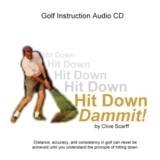Distance & Technology Part 3: Driver
Shaft
Read Part 1 of this
series here.
Read Part 2 of this
series here.
Over the next few
months, as we lead
up to a new golf
season for everyone,
the topic of my newsletter
will be how new Driver
Technology provides
greater distance
to us all. If you
have been thinking
of purchasing a new
driver this season,
hold off until you
get a better understanding
of what's out there.
If there is any
topic you would like
explained and presented
in my upcoming newsletters,
just email me. I'll
attempt to cover
your topic in a future
newsletter.
If you'd
like one on
one explanations
about the topic,
sign up for the PGI
Member Select Club and
I'll answer all your
questions. Now on
to this week's topic.
III. Clubhead
Shaft
As
presented in previous
newsletters, to
achieve maximum
distance, the golfer
must provide the
clubhead with as
much energy (and
thus speed) as
possible. Because
of the very short
duration of impact
(about 0.0005 seconds),
the golfer has
no influence on
the transfer of
energy between
the club and the
ball. It's as iff
the clubhead were
not attached to
the shaft at that
point. In fact,
very little of
the shaft's mass
contributes to
the transfer as
well.
Thus
it essential to
have as light of
a shaft as possible.
A heavy shaft merely
adds mass to what
the golfer is swinging,
thus reducing clubhead
speed and distance.
Ideally, the shaft
would have no mass
at all. Unfortunately,
the shaft must
have sufficient
mass to have enough
strength so the
club doesn't twist
to much. The forces
on the clubhead
at impact are extremely
large (and thus
the forces on the
golfer's hands
are large as well;
the cause of calluses).
At and near impact,
the clubhead's
toe will tip downwards
and clubface forwards.
Both of these changes
open the clubface
slightly and increase
its effective loft.
Many
think that the
kicking forwards
of the clubhead
increases clubhead
speed, thus one
wants a shaft that
is stiff enough
to reduce twist
and but not too
stiff to reduce
clubhead speed.
In actual fact,
it has been found
through high speed
camera measurements
that the increase
in clubhead speed
is not significant.
A more flexible
shaft does not
increase clubhead
speed significantly,
but it does increase
the amount of twisting
and therefore the
amount of dispersion
of golf shots.
Long
hitters should
use the stiffest
and lightest shafts
possible. Short
hitters on't benefit
from more flexible
shafts. For short
hitters, the difference
between stiff and
flexible is just
preference of feel.
More flexible shafts
will kick more
at impact thus
opening the clubface
more and increasing
effective loft.
As was presented
in my last newsletter,
effective loft
(influenced by
club loft, center
of mass, and shaft
flex) determines
maximum distance.
|
|

Learn
your perfect
swing while
attached
to the "Dream
Swing."
|
The
lightest shafts
on the market that
are also strong
enough are made
of graphite. Steel
shafts are stronger
but have significantly
more mass (120
g compared to 90
g). Even so, for
a long hitter,
a steel shaft driver
would yield only
about 5 - 6 yards
less distance.
A short hitter
would find similar
differences. But
5 - 6 yards difference
for a short hitter
is much more significant.
Long hitters do
get more distance
with graphite shafts
but do sacrifice
some control.
The
difference in price
for a steel shaft
and a good graphite
shaft is quite
substantial. You're
paying a lot of
money for a few
extra yards. It's
the same with most
things one purchases,
you pay a lot of
money for the more
luxurious model.
Play
with my Driver
Distance Calculator.
You can input such
variables as loft
and clubhead speed
to determine the
optimum loft.
If
you are serious
about
trying to optimize
your distance through
clubhead loft, go
to a facility that
has a club/ball monitor
(one that measures
clubhead speed, ball
speed, trajectory,
spin, etc). You can
experiment with different
clubhead lofts to
find the one that
produces optimum ball speed,
trajectory and spin.
A list of resources that have been used to produce this newsletter
can be found on my
website here.
The next newsletter's topic will be the size of the driver clubhead
and its moment of inertia.
Is bigger definitely
better? Does a bigger
clubhead mean more
air drag thus less distance?
The focus
of my site
is to utilize science
and math to lower
your score. New technology
is one
way to achieve this,
but to be honest,
the technology is
one small piece of
the puzzle.
To actually improve significantly,
we all need to:
1. Improve our swings. Hit
Down Dammit!
2. Improve our physical fitness
and strength.
The
Golf Trainer Power
Performance Programô
3. Improve our mental games.
Golf Mind Software
4. Improve our Probable
Golf games.
Learn how to make better
choices on the course
through knowing how
shot patterns and reading
the elements and course
better.
Click on the links above to
take a look at
ways that I personally
use myself and
recommend you try
as well.
Get ready for this season's matches and club events. Find out
what handicap mix in
a foursome produces
the lowest scores.
How can one play a
fair birdie game amongst
different handicap
groups?
There
are 3 reports:
Report
#1:
Team Events
Report
#2:
Match
Play & Stroke
Allocation
Report
#3:
Birdie
Ratios & Other
Scores
Each
report can be downloaded
immediately for $7.99
or all three can
be purchased for
$19.99.
For
Newsletter Members
Only (that's you),
all three reports
can be purchased
for a special discounted
price of $14.99,
but only by using
the link below.
Take
a closer look at
some of the details
of the reports HERE,
and then come back
here to order.
Pay
$14.99 thru 2CheckOut 
Goods and services
provided by Probable
Golf Instruction
(BC, Canada).
Sold by 2CheckOut.com Inc. (Ohio, USA).
Once
processed by
2CheckOut, you
will be prompted
with a link to
download. Since
the time is very
limited, you
should download
immediately.
OR
Pay
using
Hope
I provided some useful
ways for to become
better prepared for
you best golf season
ever.
Ken Tannar
|








